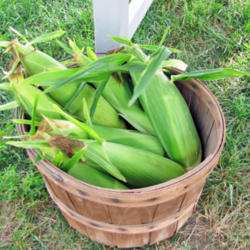
Most of the trouble gardeners have with corn is easily controlled. Diseases aren't much of a problem, and insects can easily be kept in check. Birds and four-footed visitors who want to share your corn harvest can be kept out with any number of scare-off devices and fences. Prevention can be 100 percent of the cure. If you sow your corn in well drained soil that has balanced nutrient levels, you're on the road to having healthy plants. Healthy plants can withstand nibbling or insect damage better than weakened ones. In many cases, a crop that's healthy will often be spared disease and insect attack altogether.
A very important step you can take for disease-free corn is to clean up all the cornstalks as soon as the harvest is over. Till healthy cornstalks into the soil as additional organic matter, or, if you prefer, shred, compost or simply discard them. Dealing with old cornstalks will prevent many diseases and insects from overwintering, which is crucial to the health of crops grown in future seasons.
DiseasesStewart's Bacterial Wilt can affect sweet corn at any stage, but is most harmful to young plants. It causes dwarfing and wilting of the plants, and the tassels often develop early and die without completing pollination. Leaves develop yellow-brown streaks and wavy edges. The leaves of young plants may dry out, and the stem eventually dies. This wilt is often characterized by a yellow slime on the inner husks and in the stem. Bacteria overwinter in the gut of the corn flea beetle. This disease is prevalent after a mild winter, when more disease-carrying flea beetles have survived. To prevent an outbreak, clean up all crop residues, rotate your corn crop each year, plant resistant varieties and control corn flea beetles.
Root Rot is caused by fungi in the soil and shows up as stunted plants or irregular plants with rotten roots. You risk root rot when planting seed in cold, damp soil. Use treated seed, plant on raised beds if soil drainage is a problem and wait until the soil temperature is 55° F before planting.
Corn Smut is caused by a soil fungus, and can strike corn anywhere it's grown. Smut looks awful, but it's not a disastrous condition. Smut is edible and actually is sought after by gourmet chefs. In the early stages of the infection, grayish white, spongy growths called "galls" usually appear on the corn ear or tassel. As these galls ripen, they turn black and eventually burst open, releasing powdery spores that spread the smut. The disease thrives in hot, dry weather and often infects weak or injured plants first. To prevent, rotate crops, and if you notice any galls, pick them and burn them before they blacken and burst. This will halt the smut's spread and is often all it takes to keep the disease in check from one season to the next.
Southern Corn Leaf Blight is another fungal disease. It is characterized by tan streaks or lesions on the leaves, and may cause early seedling death, mold-covered kernels or rotten cobs. A similar disease, northern corn leaf blight, results in grayish green or tan lesions on the leaves and reduced yields. These fungi overwinter in infected seed and plant debris. Plant resistant varieties, using healthy, certified disease-free seed. Rotate crops and remove or till under crop debris. If the disease has been severe in your area, check with your local Extension agent for a preventive fungicide program. In 1970 this blight reached epidemic proportions, wiping out 15 percent of the total United States corn crop, for an estimated loss of one billion dollars.
InsectsThese are the insects most likely to affect corn, along with the best control measures for the home gardener.

Corn earworm is also known as the tomato fruitworm or cotton bollworm. This 1- to 2-inch-long caterpillar ranges from light green to purplish brown. Moths lay eggs on corn plants in early summer and larvae feed first on the silks, then on the kernels at the tip of each ear. The insect can prevent pollination, and it opens kernels to fungus invasion. To discourage this pest, select varieties with tightly closed husks. Earworms can be controlled somewhat by squirting mineral oil into each ear after silks have started to dry, using half a medicine dropper per ear. You can also spray the plant and silks with Bt. If earworm damage occurs, clip off the tip of the ear and any affected kernels. The rest of the ear should be fine to eat.

European corn borer is a 1-inch-long tan or brown caterpillar sporting rows of dark brown spots and a dark brown head. The moths fly mostly at night and lay eggs on the undersides of corn leaves in early summer. The hatched larvae bore into cornstalks and ears to feed. Broken tassels, bent stalks and "sawdust" around corn are all signs of borer damage. If you catch it in time, you can often cut out the borer from the stalk with no permanent damage. To prevent infestation, treat ears and leaves with Bt as soon as silk has partially emerged. Spray with an organic pesticide at five-day intervals from the time you first spot borer activity or when the tassels begin appearing. Make at least two applications for best results. Be sure to till or spade under crop residues at the end of the season so the borer has no place to overwinter.
Corn Sap Beetles are small, black beetles that spawn maggot-like larvae that eat into the kernels of roasting corn. Larvae are whitish and up to 1/4 inch long. The beetles are attracted to the scent of damaged corn, so preventing feeding by other pests helps keep them at bay. To prevent, plant resistant varieties and clean up all crop residues. Southern corn rootworms are small, yellowish grubs of the spotted cucumber beetle. They weaken corn plants by feeding on roots, causing the stalks to blow over easily in wind or heavy rain. Adults lay eggs around roots of cornstalks in the fall. The eggs hatch in spring. You can avoid damage from corn rootworms by tilling under cornstalks and rotating crops each year.
Corn Root Aphids are tiny, light green insects that feed on corn roots, causing the plants to be stunted and yellowed. The aphids overwinter in the nests of cornfield ants. The best way to control this pest is to plow the garden in the fall, destroying ant nests. Corn Flea Beetles are small but dangerous. Only 1/16th of an inch long, these jumping black beetles chew corn foliage and transmit Stewart's bacterial wilt. The pests abound during cool, wet periods and after mild winters. They hibernate in weeds and plant debris over the winter, so keep the garden and surrounding areas clean. Many of the later-maturing white corn varieties are resistant to wilt. To repel flea beetles, sprinkle a light dusting of wood ash over plants and soil.
Wireworms are slender, yellowish or brown larvae of click beetles. These 1/2- to 1 1/2-inch-long worms resemble a jointed wire. They damage corn plants by feeding on the roots. These pests are most often present in newly worked sod. Rotate crops and till or spade your garden thoroughly in the fall. Heavy infestations may require soil treatment with beneficial nematodes before planting.
Seed corn maggots are cream-colored and legless. The 1/2-inch-long larvae bore into sprouting seeds and prevent further growth. When early corn is planted in cool, wet soil, the slower germination makes the seeds more susceptible to maggot attack. If maggots are a problem in your area, delay planting until weather warms.
Uninvited GuestsOne of the biggest challenges in growing corn is keeping it for yourself. From the day you plant to the day you're ready to harvest, it seems there's always some critter who'd just love to share in the bounty. Fortunately, most of the animals and birds that invade corn can be outwitted. Raccoons are smarter than we'd like them to be, but they, too, can be kept at bay. Here are some ideas to keep corn free of uninvited guests. Some of these tricks can solve pest problems in other parts of your garden, as well.
Raccoons are well known for their expertly timed raids on the sweet corn patch. Many people start their tales of raccoon damage with the words, "The night before we were going to pick the first, ripe, sweet corn -." When you lose ripening sweet corn to raccoon raiders, you swear they were on hand at planting time reading your seed packets, jotting down the days to harvest and keeping track of the time back in the woods. Actually, raccoons are attracted by the smell of the sweet corn tassels.
There are many old-time tricks to keep raccoons out of the corn patch, but only one rule: Put your defense in action before the raccoons can set a single foot in your garden. Once an animal has tasted your sweet corn, it will be almost impossible to keep it out of the garden.
To protect sweet corn, try these ideas:
* Erect a three-foot-high chicken-wire fence topped by an electrical wire.
* Play a portable radio in the cornfield all night.
* Plant a crop such as pole beans, pumpkins or winter squash between rows of corn. Supposedly, raccoons don't like to tread on vines or foliage covering the ground around cornstalks. Also, the lush foliage of pole beans cuts down the raccoons' ability to see, and this, too, is said to discourage their corn raids.
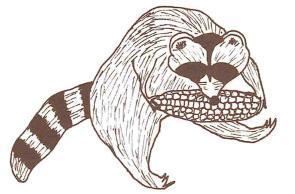
Some of the methods that keep raccoons out will also work for skunks, woodchucks, deer and squirrels. An electric fence is the best all-around pest barrier, except when it comes to squirrels. These agile creatures aren't put off by fences, electric or not. One way to keep squirrels away is to sprinkle red pepper or Tabasco sauce on some ears on the outer rows of the corn. It won't affect the corn's flavor when it's cooked, but any squirrel, skunk or raccoon who takes a nibble of the "hot" ears isn't likely to come back for seconds.
It seems there's an endless list of home remedies to try to keep the corn patch free of four-footed pests: running barefoot around the corn rows to leave a strong human scent; tying your dog near the corn to guard it; placing a paper bag over each ear; the bag of tricks seems bottomless. Some of these methods work some of the time, so try anything you think might work for you. Using several methods in succession or simultaneously increases your chances of success.
BirdsUnlike four-footed critters, birds do as much good in the garden by eating insect pests as they do damage, but some species have a weakness for corn. There are a few ways to keep birds away from the corn at each stage of the game.
After planting, cover each row with a long strip of chicken wire, bending it in an inverted U-shape about 10 inches high in the middle. The close mesh keeps out prying beaks, and by the time the seedlings touch the top of the wire, the birds are no longer interested. You can remove the wire and store it for the next season.
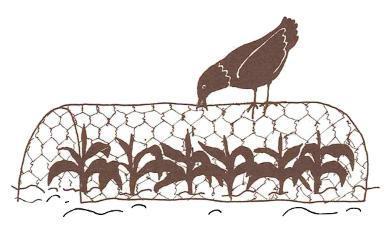
Don't bother with scarecrows. Although they might be fun for the kids to put together, they'll only serve as a handy perch for most birds. However, there are other effective ways to scare birds away. Try putting a realistic life-size plastic owl on a tall post near the corn. The owl will ward off birds, and may help with neighborhood mice and rabbits as well. Moving the owl frequently will keep critters from getting used to it too quickly.
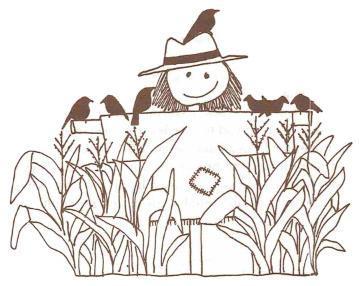
If you can keep birds away from your newly planted corn, they shouldn't bother the crop again until the ears start to fill out. Then you need an effective bird-scarer or chaser. Rig up noisemakers or aluminum pie plates around the corn to frighten them. A cat or dog near the garden often does the trick. Flashy mylar tape and scare-eye balloons can help, too.
One time-consuming, but surefire bird barrier is to tie a paper bag around each ear of corn, but only after the corn has been pollinated. This also can ward off invading insects, but it's too much work for a large cornfield. When it rains, the bags break and need replacing; and when it's windy, they often blow off.
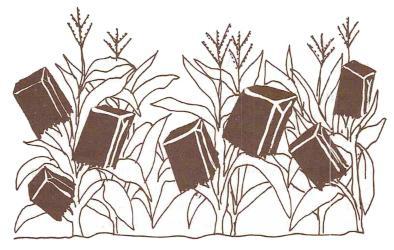
 Victory Seed Company has all the seeds you want for your best garden in 2024.
Victory Seed Company has all the seeds you want for your best garden in 2024.
For 25 years, the family-owned Victory Seed Company has provided the highest quality vegetable, herb and flower seeds to families across the country. We are passionate about providing you the best seeds available that give excellent germination, robust plants, and the harvest you want. With a catalog of over a thousand varieties, we have everything, and our prices are the kinds that we'd want to pay. We have hundreds of yesterday's heirloom vegetables, as well as today's award winning hybrid selections. Get to know us by visiting our website and browsing through our online vegetable seed catalog.
| 1. Corn Diseases, Insects, and Pests ← you're on this article right now |
| 1. Corn Diseases, Insects, and Pests ← you're on this article right now |